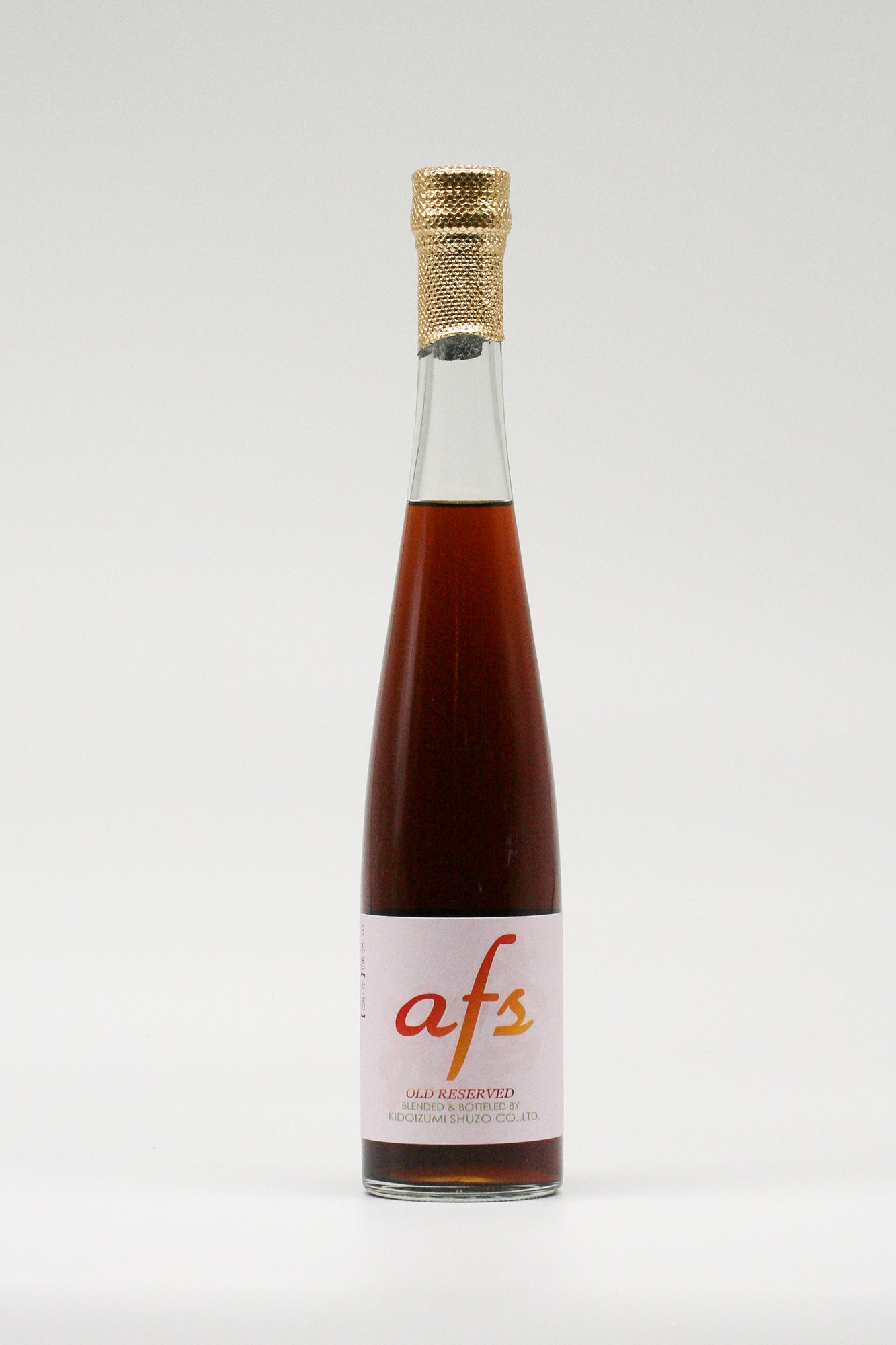


Brewed using a high-temperature method like no other, it has a deep acidity and a mellowness that supports it. The scent is gorgeous, and you can enjoy the unique world view that only Kido Izumi can offer.
AFS Old Reserve Assemblage
| Vintage | - |
| Years aged | - |
- All Products
- Amber
- Less than 5,000 yen
- NA (please search by vintage)
- Non-vintage
- Throughout the meal
- With dessert and/or as an after-dinner drink
- Brewer:Kidoizumi Sake Brewery
- Alcohol:17%
- Volume:360ml
Couldn't load pickup availability
[ Drinking alcohol under the age of 20 is prohibited by law. ]
Kidoizumi Sake Brewery has developed a brewing method called Kouon Yamahai Ichidanjikomi (one-stage fermentation), designed to craft a one-of-a-kind sake with an emphasized acidity to withstand long-term maturation.
AFS Old Reserve is an assemblage made by combining a Genshu from the 1970s with a small amount of younger sake to deliver both a mellow and gorgeous profile.
It pairs well with citrus fruits, especially oranges. From dishes like duck in orange sauce to orangette (orange peel chocolate) with a matching cacao, a myriad of beautiful marriages are possible.
- about
-
Type Assemblage Rice polishing ratio - Yeast type - Ingredients/raw materials Rice (domestic), rice koji (domestic), brewed alcohol Rice type - Origin of rice - Toji(Brew Master) - Assemblage Yes (Assemblage of unprocessed sake with a short aging period, mainly from the 1970s)
- Recommended occasions/temperature
-
- How to store
-
- Delivery dates and charges
-



Tasting comments
-
Nobuhiro Ueno
(Juku to Kan Bar Master / Permanent Director of the Toki Sake Association)Despite it being an aged sake sake, it has a gorgeous aroma. I think the word beautiful would apply here too.
It has a unique sourness that will enhance the flavor of food, and it really makes me curious to try it with all kind of cuisine.
It goes perfectly with orangette chocolate and can also be enjoyed with desserts. -
Hidekazu Ishiwata
(Former National Tax Bureau Chief Appraiser)Rich and layered as shown by its deep brown color. The orthonasal aroma is a mix of light vinegar and caramel. In the mouth, a sharp attack of acidity is followed by a grain-like taste and rice bran aroma. Its complexity and lively nature definitely feels like the work of microbes. It's pretty aromatic, but it also has a robust taste that would not be overpowered by meat dishes. It's hard to classify as a sake. It belongs to its own genre. Let's call it the Kidoizumi genre.
-
Akiko Toda
(Director of ITTEKI, Japan Sake and Meat Research Institute)It's bold color and character reminds me of matured, rich red vinegar and sherry. While mid-palate, rice and koji notes mix with an expansive fruitiness, it retains the texture reminiscent of soy sauce, sherry, and red vinegar. Seems like it would be a good match for Edomae (traditional Tokyo style) cuisine. The creativity and imagination that is imbued in this sake alone feels like it could inspire a new culinary creation.
-
Yuji Yamauchi
(Yushima Tenjinshita Sushi Hatsu 4th generation / 1st JSA SAKE DIPLOMA competition winner)The aroma is very unique and for a moment I am taken aback. The orthonosal aroma is quite mellow, which makes the the retronasal aroma stand out more. It is complex, with notes of oak, vanilla, and raisins, like a good whiskey, with a hint of chemicals.
I also detect a note like Mitarashi dumplings, but there is also a floral element. There is an apricot-ness to it.
The taste is led by the acidity. It is not sweet, so it can be paired with meals.
Because of the way it refreshes the palate, I think it would go well with chicken or chicken bones.
Brewer


Kidoizumi Sake Brewery
For over 50 years, Kido Izumi has continued to use the method of making sake mash, which uses natural raw lactic acid bacteria to prepare the mash at high temperatures, allowing the three bacteria of koji mold, lactic acid bacteria, and yeast to ferment freely. .
We continue to pursue the potential of natural lactic acid and take on the challenge of creating delicious sake with health, safety, and individuality as our themes.
We are moving forward under the unwavering vision of Izumi Kido's brewery.
After a period of time since its founding in 1899, it was in 1955 that a major turning point came to define Kido Izumi as it is today. At the decision of the 3rd generation brewer, we changed the brewing method to the ``Tsatsuyama Haimoto'' method.
At that time, it was a period of high economic growth where mass production was essential. At a time when sanzoshu, which was increased in volume with a seasoning liquid, met the needs of the masses, he was one of the first to realize the dangers of salicylic acid, which was used as a preservative, and worked to create sake that could be stored for a long time without relying on preservatives. is. Based on the strong desire of the third-generation brewer to ``make sake that does not use any additives, pesticides, or chemical fertilizers,'' in 1961, we decided to create a sake brewery that does not use any pesticides or chemical fertilizers, not only of additives, but also of the rice that is the raw material. We also began producing naturally brewed sake (currently branded as Kido Izumi Shizenmai), which is made using 100% naturally farmed rice.
Another impetus for ``brewing sake that does not go bad even after long periods of storage'' is the challenge of making sake older, or in other words, making aged sake. Approximately 10 years have passed since the switch to high-temperature Yamahaimoto, and despite repeated failures, they succeeded in producing long-term aged sake in 1966. Sake can now also be aged as old sake.
In the Showa era, the quality and price of Japanese sake deteriorated after one year of production, so Izumi Kido's determination to research brewing methods with old sake brewing in mind, and his pride as a pioneer, led to the brewery's 5 The oldest sake is over 40 years old and is still aging.



